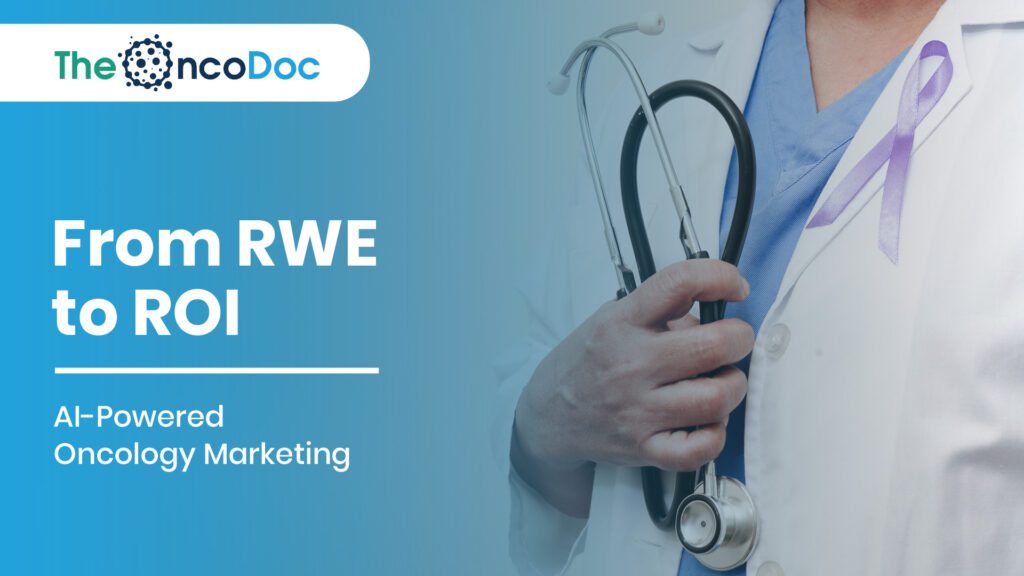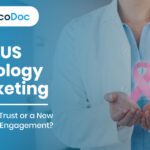Introduction: Turning Data into Impact
Oncology marketing is evolving rapidly, driven by the increasing availability of Real-World Evidence (RWE) and the growing application of Artificial Intelligence (AI). As cancer treatments become more targeted and patient populations more diverse, pharmaceutical marketers are moving beyond traditional metrics to focus on measurable outcomes that matter, both to patients and to healthcare systems
The shift from RWE to ROI is reshaping oncology marketing. By harnessing AI, pharma brands can leverage real-world patient data to create personalized outreach strategies, predict treatment adherence, and ensure that campaigns deliver tangible improvements in patient outcomes and healthcare economics. This article explores how AI-powered analytics, combined with RWE, are transforming oncology marketing into a data-driven, value-based model where return on investment is measured by better health outcomes, improved engagement, and optimized resource allocation.
1. Real-World Evidence: The Foundation of Modern Oncology Marketing
Real-World Evidence refers to healthcare data collected outside controlled clinical trials. It includes patient registries, electronic health records (EHRs), claims data, wearables, and patient-reported outcomes. RWE helps oncology marketers understand how therapies are used in practice, how patients respond to treatment, and what barriers affect adherence.
Applications of RWE in Oncology Marketing:
- Identifying patient segments: Data from EHRs and claims reveal disease patterns across regions and demographics.
- Monitoring treatment outcomes: RWE enables longitudinal tracking of therapy effectiveness in real-life settings.
- Understanding patient behaviors: Insights into follow-up rates, medication adherence, and care-seeking patterns inform outreach strategies.
- Supporting market access: Demonstrating therapy value through real-world outcomes strengthens payer negotiations.
RWE provides the context needed to move beyond one-size-fits-all messaging and create campaigns that are evidence-backed, relevant, and patient-focused.
2. AI as the Engine Behind RWE
While RWE offers vast datasets, its sheer volume and complexity require advanced tools for meaningful interpretation. AI-driven platforms can sift through billions of data points to uncover patterns that guide oncology marketing decisions.
AI Capabilities Enhancing RWE:
- Predictive Analytics: AI models forecast treatment adherence and disease progression by analyzing patient behavior patterns.
- Natural Language Processing (NLP): Extracts actionable insights from clinical notes, physician narratives, and patient feedback.
- Segmentation Algorithms: Cluster patients based on clinical profiles, socio-economic factors, and behavioral trends.
- Outcome Simulation: AI helps simulate therapy scenarios to estimate the potential benefits and risks before implementing campaigns.
These tools enable marketers to personalize messaging, allocate resources efficiently, and demonstrate the real-world impact of therapies to healthcare providers and stakeholders.
3. Moving from Insights to Implementation: AI-Powered Outreach Strategies
AI-driven insights derived from RWE translate into targeted and timely interventions that maximize patient engagement and clinical outcomes.
Key Outreach Strategies Powered by AI:
- Personalized Patient Journeys
- Dynamic messaging based on treatment stage and risk factors.
- Automated reminders tailored to individual schedules and health conditions.
- Optimized Physician Engagement
- AI-curated clinical content delivered to healthcare providers based on prescribing patterns and knowledge gaps.
- Decision-support tools for treatment planning and patient counseling.
- Real-Time Monitoring and Adjustment
- Campaigns that adapt based on patient feedback or changes in disease severity.
- Automated alerts to care teams when patients miss follow-up appointments or prescriptions.
- Behavioral Nudging
- Leveraging AI models to identify patients at risk of non-compliance and offering tailored interventions.
- Using patient-reported outcomes to refine outreach frequency and content style.
These strategies ensure that oncology marketing is no longer static but evolves dynamically with patient needs and healthcare realities.
4. The ROI Equation in AI-Driven Oncology Marketing
ROI in oncology marketing is increasingly tied to patient outcomes, operational efficiencies, and brand credibility rather than traditional metrics like reach or impressions.
Key ROI Drivers Enabled by AI:
- Improved Adherence Rates: Timely interventions result in higher therapy compliance.
- Reduced Healthcare Costs: Better patient management helps prevent complications and hospital readmissions.
- Enhanced Patient Satisfaction: Personalized communication builds trust and long-term relationships.
- Accelerated Market Access: Evidence-backed campaigns support faster reimbursement approvals.
Marketers are now able to quantify how AI-powered outreach contributes to both patient care and the bottom line.
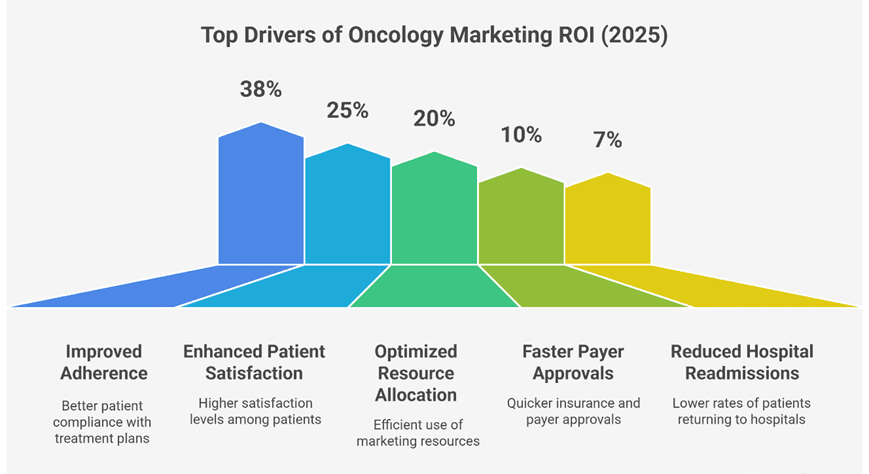
5. Overcoming Challenges in AI-Powered Oncology Marketing
Despite the promise of AI-driven models, oncology marketers face significant hurdles that require ethical, technical, and operational solutions.
Common Challenges:
- Data Privacy Concerns
- Sensitive health data requires strict governance and patient consent frameworks.
- Bias in Data
- Incomplete datasets or underrepresented populations can skew predictions, affecting campaign fairness.
- Interoperability Issues
- Fragmented data sources make it difficult to create unified patient profiles for targeted outreach.
- Adoption Barriers
- Clinicians and healthcare teams may resist AI-driven interventions due to unfamiliarity or skepticism.
Solutions:
- Implement robust encryption and data governance protocols.
- Use synthetic data augmentation to balance underrepresented groups.
- Develop standardized data formats to integrate EHRs and claims records seamlessly.
- Provide training and support for healthcare teams to adopt AI tools confidently.
6. Ethical Considerations: Balancing Innovation with Responsibility
AI-powered oncology marketing must be guided by ethical principles to ensure that patient welfare remains central to decision-making.
Ethical Pillars:
- Transparency
- Disclose how algorithms influence patient engagement and treatment recommendations.
- Equity
- Design models that account for socio-economic and demographic diversity.
- Accountability
- Establish protocols to audit AI-driven decisions and correct errors proactively.
- Patient Empowerment
- Provide patients with control over how their data is used and offer channels for feedback.
Integrating these principles into campaign design fosters trust and long-term relationships between pharma brands, healthcare providers, and patients.
7. Case Example: AI Transforming Oncology Campaigns
A global oncology brand piloted an AI-driven campaign for lung cancer patients. Using RWE from hospital networks and insurance claims, the AI platform:
- Identified patients at high risk of treatment discontinuation.
- Delivered personalized content including motivational messages and educational videos.
- Alerted care teams when patients missed medication refills.
The campaign achieved a 32% improvement in adherence rates and a 22% reduction in hospital readmissions, significantly boosting ROI while improving patient outcomes.
8. The Role of Partnerships in Scaling AI-Powered Oncology Marketing
Successful AI-powered oncology outreach relies on cross-sector collaboration between pharmaceutical companies, technology providers, healthcare institutions, and regulatory bodies.
Key Partnerships:
- Tech Firms: Provide machine learning models, NLP tools, and data integration platforms.
- Hospitals: Offer access to clinical data and patient feedback loops.
- Payers: Collaborate to demonstrate cost-effectiveness through real-world outcomes.
- Patient Advocacy Groups: Help ensure campaigns are culturally sensitive and patient-centered.
Partnerships ensure that AI-driven insights are translated into actionable, sustainable, and ethical outreach efforts.
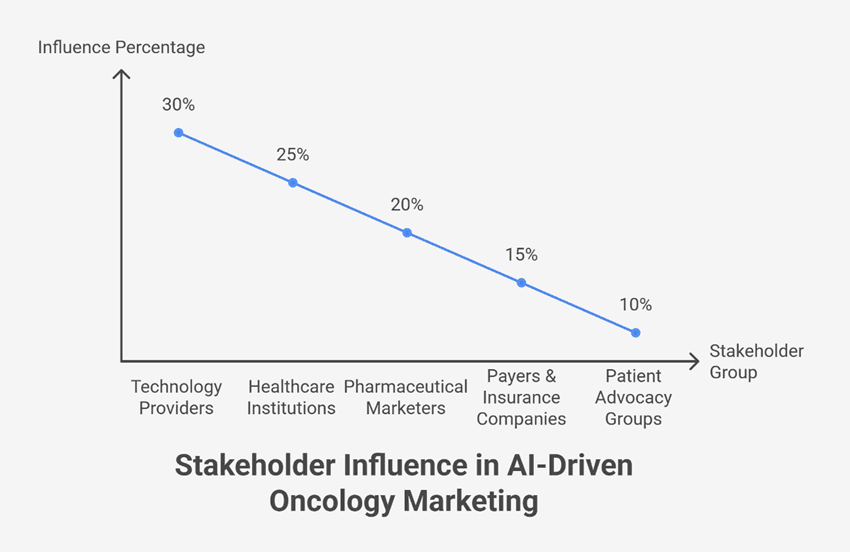
9. Measuring Success: Beyond Traditional KPIs
AI-powered oncology marketing success is measured not just by campaign reach but by tangible improvements in patient outcomes and healthcare operations.
New Metrics for Success:
- Adherence and Persistence Rates
- Time to Treatment Initiation
- Patient Engagement Scores
- Quality of Life Improvements
- Cost Savings Across Treatment Pathways
Tracking these metrics ensures campaigns are aligned with both patient needs and business goals.
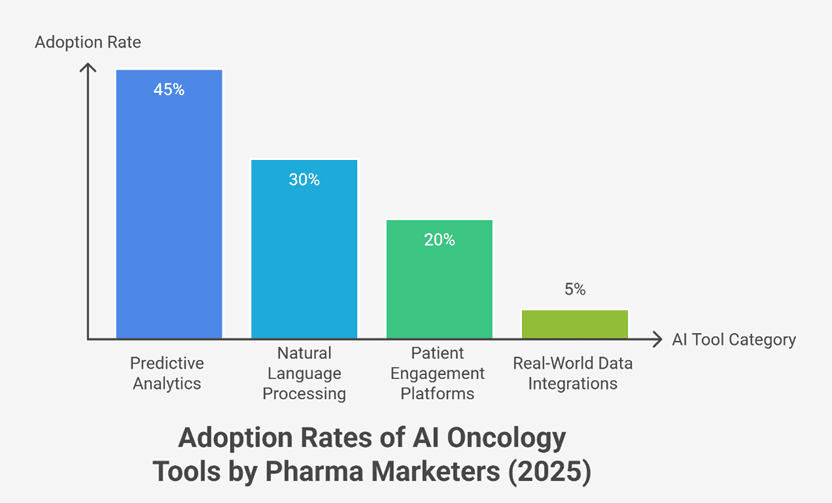
10. The Future: AI, RWE, and a Value-Based Oncology Ecosystem
As oncology marketing continues to evolve, the integration of AI with RWE promises a future where campaigns are:
- Predictive: Anticipating patient needs before symptoms escalate.
- Personalized: Delivering tailored interventions aligned with individual health profiles.
- Ethical: Upholding privacy, equity, and patient dignity.
- Outcome-Driven: Focusing on real health improvements rather than vanity metrics.
Pharma marketers who embrace this paradigm shift will not only improve ROI but also build a sustainable healthcare ecosystem where patients receive better care and providers gain deeper insights into treatment efficacy.
11. Emerging Technologies Complementing AI and RWE in Oncology Marketing
As oncology marketing evolves, emerging technologies are increasingly working in tandem with AI and Real-World Evidence (RWE) to create more precise, ethical, and outcome-driven campaigns. These technologies not only enhance the scalability of patient outreach but also improve decision-making, engagement, and resource allocation.
11.1. Blockchain for Secure and Transparent Data Sharing
Blockchain technology is transforming how sensitive patient data is stored, shared, and utilized in oncology campaigns.
Key Benefits:
- Data Integrity: Blockchain’s tamper-proof structure ensures that real-world patient data remains accurate, traceable, and free from manipulation.
- Privacy Protection: Patients retain control over how and with whom their data is shared, enabling informed consent frameworks that align with regulatory compliance.
- Interoperability: Distributed ledger systems facilitate seamless sharing of healthcare information across stakeholders, including pharmaceutical companies, healthcare providers, and insurers.
Applications in Oncology Marketing:
- Patient registries can securely log treatment histories.
- Clinical trial recruitment platforms can verify patient eligibility without compromising confidentiality.
- Blockchain-enabled portals allow patients to access personalized health dashboards powered by AI insights.
11.2. Edge Computing for Real-Time Personalization
Edge computing decentralizes data processing by bringing computation closer to the source, patients’ devices or local healthcare networks.
Key Advantages:
- Reduced Latency: Real-time data processing allows for instantaneous recommendations, such as medication reminders or appointment scheduling.
- Enhanced Privacy: Sensitive data is processed locally, minimizing exposure during transmission to central servers.
- Adaptive Campaign Delivery: Oncology marketing messages can be dynamically adjusted based on contextual factors like location, time, or patient activity levels.
Example Use Case:
A mobile oncology app integrates edge computing to process vital signs from a wearable device. If a patient’s sleep patterns or heart rate deviates from baseline, the app instantly recommends consultation or lifestyle interventions tailored to their treatment plan.
11.3. Digital Twins for Personalized Patient Simulations
A digital twin is a virtual representation of a patient’s health profile, integrating genetic data, treatment history, lifestyle habits, and environmental factors.
Benefits in Oncology Marketing:
- Customized Interventions: Marketers can simulate how different messaging, treatment schedules, or educational resources impact patient adherence.
- Scenario Testing: Digital twins allow predictive models to estimate potential outcomes, identifying risks before they materialize.
- Patient Empowerment: Visualizations and interactive simulations help patients understand their treatment trajectory and take proactive steps toward managing their health.
Use Case:
A lung cancer campaign uses digital twin simulations to educate patients on the effects of smoking cessation, nutritional adjustments, and medication adherence. The simulation offers personalized strategies that are both feasible and sustainable.
11.4. Voice Assistants and Conversational AI for Oncology Support
Conversational AI, including voice assistants and chatbots, is redefining patient engagement in oncology by offering empathetic, responsive, and accessible support.
Key Features:
- Natural Dialogue Processing: Conversational systems understand patient queries, symptoms, and emotional cues through NLP.
- Multi-Language Accessibility: Voice interfaces deliver content in regional languages and dialects, addressing health literacy gaps.
- 24/7 Availability: Automated systems offer continuous assistance, helping patients navigate treatment complexities at any time.
Applications:
- Providing medication reminders based on personalized schedules.
- Offering guidance on symptom management and nutrition.
- Facilitating appointment booking, follow-up reminders, and patient-reported outcome tracking.
These tools complement AI-powered campaigns by enhancing accessibility and humanizing interactions.
11.5. Augmented Reality (AR) for Enhanced Education and Training
Augmented Reality is increasingly being used to deliver immersive patient education and physician training programs that support oncology campaigns.
For Patients:
- Interactive 3D visuals explain tumor biology, side effects, and lifestyle modifications.
- Visual overlays in mobile apps guide patients through complex treatment regimens.
For Physicians:
- AR tools simulate treatment procedures for oncology specialists.
- Continuing Medical Education (CME) modules incorporate interactive case studies.
Benefits:
- Improved understanding and recall.
- Higher patient confidence in treatment plans.
- Enhanced provider competence in explaining therapy options.
12. Actionable Framework for Integrating AI, RWE, and Emerging Technologies
For oncology marketers aiming to translate these advanced technologies into effective campaigns, a structured framework ensures alignment with patient needs, regulatory standards, and business goals.
12.1. Data Integration and Validation
- Source Mapping: Identify all relevant data streams including EHRs, wearables, patient surveys, and claims records.
- Data Cleaning: Implement algorithms to filter out anomalies, duplicates, and outdated records.
- Validation Protocols: Cross-check data with clinical guidelines and expert input before using it for patient segmentation or campaign planning.
12.2. Personalization at Scale
- Behavioral Profiling: Use AI to cluster patients based on preferences, treatment histories, and health behaviors.
- Dynamic Content Generation: Automate message tailoring to address individual concerns, such as side effects, lifestyle interventions, or support resources.
- Feedback Loops: Encourage patients to provide input via surveys or chatbot interactions to refine algorithms continuously.
12.3. Ethical Oversight and Governance
- Consent Management: Ensure that all patient data used for personalization is backed by clear, informed consent.
- Bias Auditing: Periodically assess algorithms for unintended disparities across demographic groups.
- Transparency Reports: Provide stakeholders with accessible insights into how AI models function and make decisions.
12.4. Collaboration and Stakeholder Alignment
- Cross-Functional Teams: Bring together data scientists, oncologists, patient advocates, and regulatory experts to co-create campaign strategies.
- Training Programs: Equip healthcare providers and marketing teams with tools to interpret AI-driven insights.
- Partnerships with Tech Innovators: Collaborate with companies specializing in blockchain, edge computing, or conversational AI to scale solutions.
12.5. Outcome Measurement and Continuous Improvement
- Real-Time Dashboards: Track patient engagement, adherence, and outcomes through visual interfaces that integrate RWE and campaign metrics.
- Iterative Testing: Launch pilot campaigns, gather results, and refine models before wider deployment.
- ROI Attribution: Establish frameworks to correlate interventions with measurable outcomes like reduced hospital visits, improved patient satisfaction, or faster treatment initiation.
13. Preparing for the Next Decade: Strategic Imperatives
As AI, RWE, and complementary technologies continue to redefine oncology marketing, pharma companies must prepare for the next wave of innovation by:
- Investing in Ethical AI Research
- Ensure that models are designed with fairness, explainability, and patient welfare in mind.
- Expanding Multilingual, Culturally Sensitive Outreach
- Localize campaigns with context-aware content that resonates across diverse populations.
- Building Data Ecosystems
- Collaborate with healthcare providers and payers to create interoperable data networks that enrich predictive capabilities.
- Empowering Patients Through Education and Tools
- Develop digital platforms that guide patients through every stage of their oncology journey.
- Aligning Marketing with Healthcare Outcomes
- Focus on metrics that matter, adherence rates, patient experience, and long-term survivorship rather than vanity metrics like clicks or views.
Conclusion
The transition from RWE to ROI represents a paradigm shift in oncology marketing, one powered by AI-driven analytics, ethical frameworks, and patient-centered strategies. By leveraging real-world data to inform campaign design and measuring success through outcome-based metrics, pharma marketers are redefining the value equation in cancer care.
AI, when thoughtfully applied, is more than a tool, it is a partner in delivering equitable, effective, and compassionate oncology care. The brands that prioritize transparency, fairness, and collaboration will lead the next wave of innovation, ensuring that every patient’s journey is supported, informed, and empowered.
The future of oncology marketing belongs to those who embrace the power of data without losing sight of the human experience, where every insight serves to transform lives and every campaign is built on trust, empathy, and measurable impact.
The Oncodoc team is a group of passionate healthcare and marketing professionals dedicated to delivering accurate, engaging, and impactful content. With expertise across medical research, digital strategy, and clinical communication, the team focuses on empowering healthcare professionals and patients alike. Through evidence-based insights and innovative storytelling, Hidoc aims to bridge the gap between medicine and digital engagement, promoting wellness and informed decision-making.

